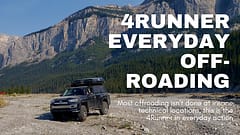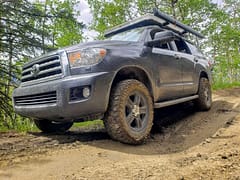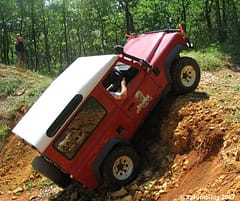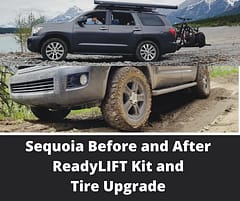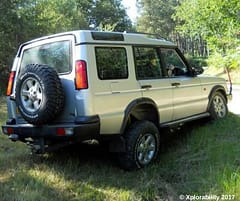How To Use 4WD Low Off-Roading
Leaving the pavement? Get more grip with 4WD low!
Contents
- Introduction
- How do I know if I have 4WD low
- If you’d rather watch than read check out:
- How do I shift into 4WD low (in a left hand drive vehicle)
- What does 4WD low do
- Land Rover Discovery 2 4WD low manual mode
- What if I have the option to lock diff (lock differentials)
- How many diffs do I have
- How to unlock your center diff
- Further information on how to use 4WD Low in a Land Rover Discovery 2
Introduction
Are you going off-road? Are there hills or big holes?
If you are leaving a paved road, going on steep inclines, over rocks, through holes, or any undulations that require intricate slow maneuvers to drive through you should have a vehicle with four-wheel-drive (4x4, 4WD) and a Low Range Transfer Case and know how to use it.
Taking The Path Less Traveled in 4WD Low Range
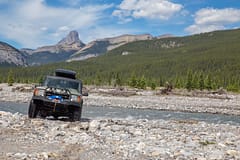
How do I know if I have 4WD low
You will likely have an additional stick shift near your regular drive selector. Or you may have a series of buttons or a dials on your dashboard.
If you’d rather watch than read check out:
How do I shift into 4WD low (in a left hand drive vehicle)
In most vehicles the recommended procedure involves bringing the car to a speed between 0 – 5 km/hour (3 MPH) and placing the car in neutral. Once in neutral move your associated 4 low dial/button/stick shift from your regular setting, likely 2 wheel drive or 4 wheel high (in AWD vehicles), to 4WD low.
4WD Low Light Indicator, Gear Instructions and Gear Shift
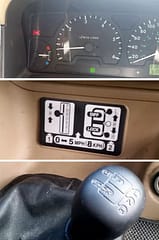
What does 4WD low do
4WD low increases the power transfer from your engine through gearing. A good analogy is 4WD low is like switching to the easiest gear on your bike, also known as the granny gear. You can go up really steep inclines more easily but you can’t go very fast.
Land Rover Discovery 2 4WD low manual mode
Land Rover Discovery 2 vehicles between the years of 1999 – 2004 came equipped with an electronically controlled manual mode to be used with a 4WD low transfer case setting. The purpose of this mode is to allow drivers to restrict the transmission into using one of it’s four gears at any time. This has proven to be extremely useful when off-roading instead of allowing the transmission to determine which gear is selected which can create a jerky and unpleasant ride. For the same reason the transmission receives far less wear-and-tear by allowing the driver to select the appropriate speed/gear for the driving conditions at hand. Starting the vehicle from a stop in low range using 3rd gear tends to be a far smoother acceleration experience on level ground when compared to using 1st gear due to the added torque provided by the low range gear set.
Shifting into 4WD low in a Land Rover Discovery 2 is a process that requires some muscle and conviction. Normal Driving is done in 4WD high with the lever pulled towards the rear and passenger side of the vehicle. Shifting to 4WD low requires a firm push towards the engine of the car. Shifting into Diff Lock from either 4WD low or 4WD high is accomplished by pushing the lever towards the drivers side in either position.
What if I have the option to lock diff (lock differentials)
Locking diffs can give you even more traction, as diffs are the connection point between your tires and engine. When diffs are open the power transfers to the path of least resistance, aka the wheel that spins the most freely. This can be the tire on loose gravel not on hard rock. When a diff is locked the power will go to both wheels equally. You do not drive in locked diffs all the time because it is hard on your diffs and axle when turning on hard pavement and could blow an axle, diff or transfer case. This could happen when turning because the wheels are required to turn at different speeds while the diffs are forcing them to spin at the same speed.
How many diffs do I have
Most likely three. On most 4WD vehicles you have a front diff between the front wheels, a rear diff between the rear wheels and a diff between the front and rear diffs that connects to the transmission, also referred to as the transfer case or center diff. Our Land Rover Discovery can only lock it’s center diff. Aftermarket front and rear diffs can be fitted through companies like ARB and Eaton.
Instead of having front and rear lockers our Land Rover has ABS based traction control system which uses braking and wheel speed sensors to help transfer power from wheels that slip to those with grip. Using the center diff lock in conjunction with the traction control system requires less input from the traction control system. This is due to the fact that when you center diff lock is engaged one front wheel and one rear wheel will always spin at the same speed, preventing an environment of wheel slippage where the traction control is set to engage. Diff lock can be used in our Land Rover in both 4 Low and 4 High settings which can be helpful in higher speed loose road surface conditions.
How to unlock your center diff
The simple answer is that unlocking your center diff is the reverse of the instructions to lock it.
In reality sometimes your center diff won’t unlock once you perform the correct steps to unlock it. This occurs when the gears bind together, also known as transmission wind up) after there is forced applied through the drive train. To solve this perform the following steps. Once in a safe location lower the vehicle speed to 0 - 5 km/hour (3 MPH) and place the vehicle into reverse. Move the vehicle backwards slowly and come to a stop after a few meters of travel. This should / will remove some of the force causing the transfer case gearing to bind. Come to a stop and then put the vehicle back into drive. Bring your vehicle up to city road speeds (not highway speeds) and you should see the diff lock symbol disappear from your dashboard. If this doesn’t occur then repeat these steps as we have seen this required twice before the diff lock properly disengaged.
If you aren’t comfortable with your off-road capabilities check out local pros that offer lessons.
Tip: Don’t wait to lock your diff, a spinning tire that quickly stops on a hard object can blow a transfer case. Lock before you rock!
Less Slip and More Grip
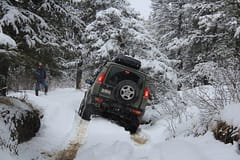
Further information on how to use 4WD Low in a Land Rover Discovery 2
Other articles your might be interested in: Learn How to Best Use ABS, TC and HDC
